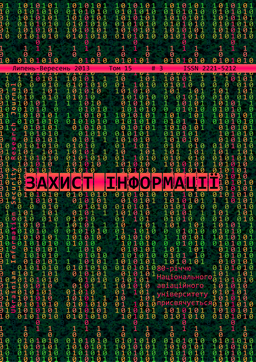The method of terms transformation of linguistic variables in decision-making analysis and information security risk assessment
DOI:
https://doi.org/10.18372/2410-7840.15.4865Keywords:
risk, risk analysis, risk assessment, risk assessment and analysis, risk parameters, linguistic variable fuzzy variable, standard values, terms transformation of linguistic variables, equivalent terms transformation of linguistic variablesAbstract
One of the stages to develop a complex data protection system and Information Security Management System (ISMS) is provided by implementing the process of analysis and risk
assessment. In relevant systems, when assessing die fuzzy conditions to interpret a natural language descriptions the linguistic variables with a certain number of terms that appear fuzzy numbers are used. In practical use of mentioned systems, there are situations when it is convenient for analysis and risk assessment, to apply standards with die ability to vary the number of terms. For this purpose the redefinition of die specified standards without participation of experts is necessary. A solution for this task is the offered method which provides an analytical function and enables to transform (die equivalent conversion) more terms of linguistic variables to less. Such approach will enhance die flexibility of developed assessment techniques based on die logical and linguistic approach and use to describe die linguistic variable die trapezoid and triangular fuzzy numbers.
References
Казмирчук С.В. Анализ и оценивание рисков информационных ресурсов / С.В. Казмирчук // Защита информации — 2013. — Том 15 №1 (58).-С. 37-46.
Казмирчук С.В. Анализа и оценивания рисков информационных ресурсов в нечетких условиях / С.В. Казмирчук // Защита информации - 2013. - Том 15 №2 (59). - С. 133-140.
Корченко А.Г. Анализ и оценивание рисков информационной безопасности. Монография. / А.Г. Корченко, А.Е. Архипов, С.В. Казмирчук — К. : ООО «Лазурит-Полиграф», 2013.-275 с.
Корченко А.Г. Интегрированное представление параметров риска / А.Г. Корченко, Е.В. Иванченко, С.В. Казмирчук // Защита информации - 2011. - №1 (50).-С. 96-101.
Корченко А.Г. Методология синтеза систем анализа и оценки риска потерь информационных ресурсов / А.Г. Корченко, С.В. Казмирчук // Защита информации — 2012. — №2. - С. 24-28.
Корченко А.Г. Методы анализа и оценки рисков потерь государственных информационных ресурсов / А.Г. Корченко, В.П. Щербина, С.В. Казмирчук // Защита информации — 2012. - №1. - С. 126-139.
Корченко А.Г. Построение систем защиты информации на нечетких множествах. Теория и практические решения / А.Г. Корченко — К. : «МК-Пресс», 2006. - 320с.
Корченко О.Г. Системи захисту інформації. Монография. / О.Г. Корченко — К. : НАУ, 2004. - 264с.
Kazmirchuk S.V. Risk analysis and assessment of information resources, Zahist informacii, 2013, УОГ. 15 №1, pp. 31-38.
Kazmirchuk S.V. Risk analysis and assessment of information resources in fuzzy conditions, Zahist informacii, 2013, УОГ. 15 №2, pp. 133-140.
Korchenko A.G, Kazmirchuk S.V, Arkhipov A. E. The analysis and assessment risks information security. Monograph, 2013, 275 p.
Korchenko A.G, Ivanchenko Ye.V, Kazmirchuk S.V. Integrated view of risk characteristic, Zahist informacii, 2011, №1 (50), pp. 96-101.
Korchenko A.G, Kazmirchuk S.V. The synthesis methodology of analysis systems and risk assessment of information resources losses, Zahist informacii, 2012, №2, pp. 24-28.
Korchenko A.G, Sherbina V.P, Kazmirchuk S.V. Risk analysis and assessment methods of government information resources losses, Zahist informacii, 2012, №1, pp. 126-139.
Korchenko A.G. The construction of security systems on the fuzzy sets. Theory and practical solutions, 2006, 320 p.
Korchenko A.G. Information security systems. Monograph, 2004, 264 p.
Downloads
Issue
Section
License
Authors who publish with this journal agree to the following terms:- Authors retain copyright and grant the journal right of first publication with the work simultaneously licensed under a Creative Commons Attribution License that allows others to share the work with an acknowledgement of the work's authorship and initial publication in this journal.
- Authors are able to enter into separate, additional contractual arrangements for the non-exclusive distribution of the journal's published version of the work (e.g., post it to an institutional repository or publish it in a book), with an acknowledgement of its initial publication in this journal.
- Authors are permitted and encouraged to post their work online (e.g., in institutional repositories or on their website) prior to and during the submission process, as it can lead to productive exchanges, as well as earlier and greater citation of published work (See The Effect of Open Access).

